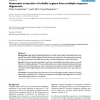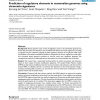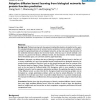50 search results - page 4 / 10 » What can we learn from noncoding regions of similarity betwe... |
BMCBI
2007
13 years 7 months ago
2007
Background: High quality multiple alignments are crucial in the transfer of annotation from one genome to another. Multiple alignment methods strive to achieve ever increasing lev...
BMCBI
2008
13 years 7 months ago
2008
Background: At intermediate stages of genome assembly projects, when a number of contigs have been generated and their validity needs to be verified, it is desirable to align thes...
AAAI
2006
13 years 8 months ago
2006
We present a cognitive model that bridges work in analogy and category learning. The model, Building Relations through Instance Driven Gradient Error Shifting (BRIDGES), extends A...
BMCBI
2008
13 years 7 months ago
2008
Background: Recent genomic scale survey of epigenetic states in the mammalian genomes has shown that promoters and enhancers are correlated with distinct chromatin signatures, pro...
BMCBI
2008
13 years 7 months ago
2008
Background: Machine-learning tools have gained considerable attention during the last few years for analyzing biological networks for protein function prediction. Kernel methods a...



